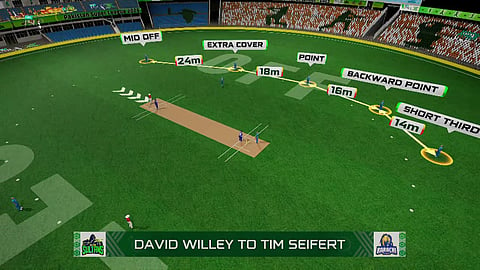Batting and bowling metrics have redefined the world of cricket broadcasting over the course of the last decade. (More Cricket News)
How Innovative Player Tracking Enhanced Coverage During PSL 2025
Just like every run of a batter is logged in and every ball delivered and wicket taken is mapped for a bowler, every fielder should be monitored for each and every delivery and then the game would truly move from being two-dimensional to three-dimensional
From the initial days of ‘Strong Zones and Weak Zones’ and ‘Keys to Success’ to advance metrics such as score and win predictors, match-ups, phase-wise analyses, ball by ball data coupled with AI and modern audio-visual technology has completely revolutionized live data-story-telling in cricket.
However, the third dimension of the sport – ‘Fielding’ – has been largely neglected with very little emphasis placed on defining a set of performance indicators for the 11 players on the field of play.
Thus, on the few rare occasions, when I switched over from the IPL to the PSL this season, it was refreshing to see some novel Player Tracking (PT) metrics introduced in the coverage.
From REGION BETWEEN TWO FIELDERS to RUN-OUT DISTANCE to the THROW SPEED, TV Conal - a technology startup based out of Singapore, combined state of the art methods in machine learning, computer vision, and artificial intelligence to build applications for Player Tracking (PT) for the ongoing season of the PSL.
One of the most innovative metrics which caught my eye was the REGION BETWEEN TWO FIELDERS – this basically highlights the triangular area between the striker and two closely positioned fielders.
It is particularly useful in analysing all the fours hit during a match and helps in gauging the ability of the two fielders in preventing the boundary. I remember watching this when Usman Khan hammered Hasan Ali for a four past backward point in the sixth over in the clash between Multan Sultans and Karachi Kings in Karachi.
This metric can be of great tactical nuance for both the batting and fielding captain. If the distance between the two fielders is less and still the batter manages to pierce the gap consistently during a match, his ‘risk appetite’ is high and there is a strong chance that he may hole out to one of the two fielders.
On the other hand, if a batter hits the fence frequently where the distance between the two fielders is large, it suggests that the fielding captain has not optimized the field placement.
From a batting team point of view, analysts can study the field coverage and coach certain batters to target those areas where the coverage is the weakest to maximize boundaries. The batters can be encouraged to harness and practise specific types of shots based on the distance between the fielders.

RUN-OUT DISTANCE was another PT metric which was showcased on more than one occasion. This metric measures the distance between the final position of the fielder (at which he collects the ball) and the end to which he throws the ball.
A related metric shown regularly was THROW SPEED which innovatively calculated the speed of the fielder who collected and threw the ball at either end.
By logging all run-outs, this metric will be very useful in determining the agility of a fielder in effecting a run-out. This will help teams in benchmarking different fielders and set standards. The swifter fielders would be placed strategically in important positions to save runs or to create potential runout chances.

Then there were the regular ones like FIELD POSITION WITH WAGON ZONE, which merges the field set for a particular batter with his actual scoring areas in a match, CATCH DISTANCE and DISTANCE BETWEEN TWO FIELDERS.

This whole new gambit of fielding metrics could completely revolutionize the manner in which a fan views a cricket match.
By systematically monitoring every fielder at every ball for every match and combining it with ball by ball data, a new set of Fielding Parameters like Runs Saved by Each Position/ Player, Best Fielder at Different Positions, Fielder Most Likely to Effect Run-Out, Strategy with Field Placements against Particular Batters in Different Phases of Play etc can be devised which will not only transform cricket broadcast but also be a defining moment in Fielding High-Performance by creating a new set of Fielding KPIs.
Just like every run of a batter is logged in and every ball delivered and wicket taken is mapped for a bowler, every fielder should be monitored for each and every delivery and then the game would truly move from being two-dimensional to three-dimensional!